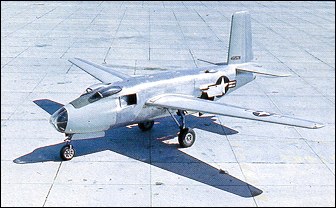 |
Douglas XB-431946 |  |
| EXPERIMENTAL BOMBER | Virtual Aircraft Museum / USA / Douglas |
 |
Anxious to speed the development of a pure jet bomber, the US Army Air Force contracted Douglas to produce two Douglas XB-43 bomber prototypes using the basic design of the XB-42. The proposed conversion was comparatively simple, replacing the XB-42's Allison piston engines with two turbojets and providing them with air inlets, incorporating two extended tail pipes to discharge the jet efflux at the tail, and replacing the cruciform tail unit with a conventional structure which, however, had a fin and rudder of increased height and area by comparison with the XB-42. To save time it was decided to modify the XB-42 static test air-frame to produce the first XB-43. It was a short-cut plan doomed to disappointment, with seemingly endless delays resulting from the war's end and the provision of the turbojet powerplant. Eventually, the XB-43 was flown for the first time on 17 May 1946. By that time, however, and despite the prototype's good overall performance, the USAAF was already looking to much-more-capable turbojet-powered bombers. Thus this, the US Army Air Force's first jet-bomber, was used only for flight-test purposes. The second prototype was completed and delivered in May 1947, being used as an engine testbed before it was retired in late 1953. Douglas XB-43 on YOUTUBE
|  COMPANY PROFILE | |||||||||||||||||||||||||||||||||||||||||||||||||||||||||||||
 |

|


